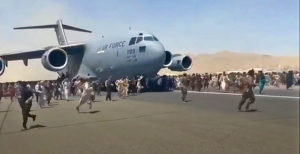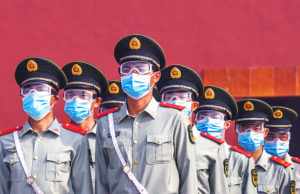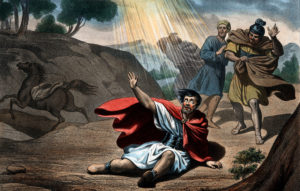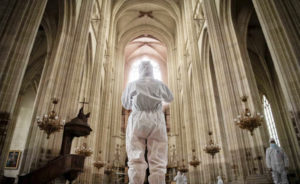In the summer of 1990, I stood where the wall had been and wondered at what had happened to Europe. I wasn’t alone: the rest of the city, the rest of the continent, was wondering too.
I was 18 years old, interrailing around Europe with a friend to see what the world looked like beyond our provincial English town, and I had accidentally wandered into a pivot point in history. In the divided German capital, less than a year before, World War Two had finally come to an end, with no shots fired.
The joy was palpable everywhere. By the time my friend and I got to the Brandenburg Gate, half of the wall had already been chipped into bite-sized pieces, which were being sold to tourists by enterprising locals, along with suddenly useless Soviet army uniforms, military passbooks and the helmets of East German border guards. Marxism hadn’t been dead a year, and the market economy was already booming. The world, or the little part of it that I knew, had suddenly changed shape entirely.
Everyone of my generation grew up with the Cold War hanging over them. The possibility of nuclear armageddon was as ever-present for teenagers then as climate change is today: we didn’t think about it much, but it was the background hum of our lives. Nobody thought the Russians would invade, really, but there didn’t seem much chance of them going away either. There was always a chance of their tanks rolling across some border somewhere, or so the Americans kept telling us. Plus ça change.
This was just the way the world was: the free West and the unfree East. If you didn’t believe that story, then one look at the wall, the barbed wire, the machine gun towers and the fate of those who tried to cross the “death strip” from East to West would make you think again.
And then, just like that, communism fell. This system that was supposed to free the people from exploitation and oppression, but had quickly become a monster itself. We didn’t know what was coming next. But from today’s perspective we can see that the fall of the East ushered in a new era.
After the wall would come a unipolar world, dominated by finance capital, overseen by the United States of America, the last empire standing. Its architects told us we were entering a long age of benign “globalisation”, in which “free markets”, human rights and democracy would spread around the world as naturally as the sun rose in the morning. The future would be free, open, liberal, prosperous and, well, American.
30 years later, we live in a world in which most Russians have a positive view of Stalin, and their current leader is mustering the biggest army since Soviet times on the border of a neighbouring state. The once-free-ish West is boiling in a stew of hate speech laws, vaccine mandates and ever-accelerating censorship and intolerance. “Populists” continue to barrack and harass its leaders, who still have no idea what to do about it: witness Justin Trudeau running away from the big scary men in their lorries. The last global empire is led by a confused octogenarian, and within a few years the biggest economy in the world will be a communist dictatorship. We didn’t see that one coming back in 1990.
Remembering the rubble strewn across Potsdamer Platz, it’s hard not to miss the End of History. In those halcyon days, I thought I lived in something called “the free world”. The liberal West was supposed to be the point on which the arc of history converged. We wanted it to be true, that story, but history has a habit of rolling on, and people don’t change, not really. I’m just grateful to have been there.
Looking back, we can see that what happened when the wall fell was not the triumph of freedom over oppression so much as the defeat of one Western ideology by another. The one that came through was the oldest, subtlest and longest-lasting, one which disguised itself so well that we didn’t know it was an ideology at all: liberalism.
This was the thesis of Patrick Deneen’s 2018 book Why Liberalism Failed, written before the populist wave of 2016, and perhaps the most reliable guide to the world we live in now. In his telling, liberalism was one of three ideologies that dominated the world over the last three centuries. The other two — communism and fascism — were shorter lived, and died in the West in the twentieth century. Liberalism — the elder brother — is only dying now. One reason for its comparatively long life is that it piggybacked on older stories, presenting itself as the inheritor of established traditions of liberty when in fact it was something quite different.
The ideology of liberalism has, since it emerged from the Enlightenment, claimed to liberate the individual from oppression. In practice it has manifested as the process of breaking all borders, limits and structures: of bringing down walls. The societies we have built around this way of seeing claim freedom for the individual from society itself, and proffer a radical notion of human nature. Rather than seeing humans as hefted creatures, rooted in time and place, liberalism offered a new conception: detached, sovereign personhood. Humans were now “rights-bearing individuals who could fashion and pursue for themselves their own version of the good life.”
What is crucial to understand — and this is what makes liberalism an ideology — is that in order for the liberal world to come into being, it needed to be created. Just as Marxist regimes attempted to destroy the traditional family, the church and private land ownership so that communism could materialise, so liberalism did not naturally “evolve” from previously existing arrangements. It needed to artificially create the “sovereign individual” from new cloth.
After the trauma of the Reformation, the Western nation-state took over the functions of the ailing Church, colonising for itself the sense of sacredness and obedience once demanded by religion. In this “migration of the holy” our religious sensibility was redirected from its proper focus towards worldly political constructions, and this in turn laid the ground for the revolutions of the modern age.
Each of these upheavals, whether in Jacobin France, Marxist Russia or Nazi Germany, failed to create the promised utopias. But they did have the effect of clearing away the traditional structures of the pre-modern era. And into the void rushed industrial capitalism — the system which G. K. Chesterton called the “monster that grows in deserts” — with its sensibility of control, measurement, utility and profit. Liberalism was, and remains, its nursemaid and press officer.
Liberalism, like its competitor ideologies, is in this way totalitarian: ruthless and all-encompassing. But it outlasted its rivals because it promised not tyranny and order, but the messiness of a certain kind of freedom. At the height of the liberal age, in the nineteenth and twentieth centuries, individual human freedom was indeed possible in the West as it had never been before. Humans, or some of them, could detach themselves from their backgrounds and origins and seek something new, and plenty of us did. Openly tyrannical government became harder to sustain, oligarchies were required to subject themselves to regular plebiscites to sustain their power, previously ignored groups in society clamoured for access to its heartlands, the rule of law protected the poor as well as the rich, and capitalism’s Luciferic power created previously unheard of levels of wealth, as well as grinding poverty.
But in liberalism’s very success lay the seeds of its failure. The project of liberating the individual from his or her networks of loyalty, locality, family and culture, and the unleashing of the vast destabilising engine of capitalism, created a social instability which could only be controlled or directed by the last institution standing: the State.
An ideology premised on protecting and promoting the freedom of the individual led to the era of unprecedented state power we live in today. Governments now claim the right to direct our speech patterns, regulate our lives and businesses to increasingly radical degrees, shut down whole societies in the name of “public health”, and even legislate for acceptable and unacceptable attitudes and opinions.
The cultural ructions of today’s West — the cancellations and contradictions, the screaming matches over race, gender, history and identity — all of this is the manifestation not of liberalism’s failure but of its success. The “progressives” who are aggressively cramming identity politics into every crevice of society have met with resistance from many self-professed liberals. These woke radicals, they cry, are destroying our culture with their fanaticism! We need to return to “classical liberalism”! But culture wars happen when no real culture remains; and 200 years of “classical liberalism”, manifested in the economic and the cultural spheres, have seen to that.
This is the legacy of an ideology which has been championed for centuries by both “Left” and “Right”. We have all become islands of self-definition, and we see now where that leads. A society premised on freedom becomes daily more fearful and closed. A society which boasts of its “diversity” becomes daily more homogenous. We can invent our own gender at will, and yet genuine individuals are in short supply, old-fashioned eccentricity is positively persecuted and originality has become career-ending. The Internet has enabled self-expression on a previously unimagined scale, and the result has been violent groupthink. The self, it turns out, mostly doesn’t have much to say.
But there’s more. Liberal ideology, as well as redesigning culture, must also redesign nature. In all the discussions of liberalism and its discontents that we’ve seen in the last few years, few seriously consider the power source that allowed the liberal age to conquer all before it: fossil fuels.
Without steamships, cars, planes, factories, supermarkets, modern roads, the Internet, the smartphone, the project of liberation would have been much less far-reaching. Fossil-fuelled liberalism allowed people to abandon place-based community, and to create for themselves an individual identity in an isolated but free kingdom of the self. But as the historian Dipesh Chakrabarty puts it, “the mansion of modern freedoms stands on an ever-expanding base of fossil fuel use”. Everything from mass democracy to feminism to multiculturalism to human rights floats on a vast bubble of fossil energy: . Nothing about the modern West could exist at all without vast concentrations of fossil energy: a fact of which Mr Putin is well aware.
Liberalism, like modernity itself, requires a war against nature; but it is a war that can never be won. As the climate shifts in response, the excesses of liberalism, and the project of self-creation it enabled, will not be possible. We will no longer be able to outsource our muscles or our minds to technology. We will need each other again — whether we like it or not.
So what comes after liberalism? The question has filled plenty of column inches in recent years, but the Covid years have brought into sharp relief the likely future we face. In Why Liberalism Failed, Deneen predicts that two post-liberal worlds are on offer: “a future of self-limitation”, in which people choose to practice “self-governance in local communities”, or “a future in which extreme licence coexists with extreme oppression”.
I know which I’d prefer, but I also know which looks most likely. As extreme individualism deepens, and an all-powerful state intervenes ever more deeply and widely to manage the resulting fragmentation, Western democracies show every sign of transforming openly into authoritarian oligarchies in which dissent — especially dissent aimed at liberalism itself — is ruthlessly suppressed by politicians who claim to represent “the people”. The vast bulks of those stationary Canadian trucks are currently the perfect symbol of this process.
The immediate future looks to me like the grinding down of what previous norms remain, and the parallel expansion of the State-corporate leviathan to both mop up the resulting mess and profit from it. That in turn will generate more “populist” (i.e. anti-liberal) reaction from both “Left” and “Right” and neither, and a consequent deepening of repression and propaganda from the besieged minority defending the remains of the liberal order. All of this will take place in the context of a planet with nearly ten billion people on it, hitting economic and ecological limits on all sides.
It seems likely to me that the liberal era will end much as the communist one did: flailing and corrupt, hiding behind walls of its own making, its leaders in denial but its people increasingly open-eyed. Perhaps the Russians won’t roll into Ukraine and spell the end of the vaunted “liberal order”, but its end seems to have been baked in from the beginning. All ideologies are based on a view of human nature that looks better on paper than in the confusing mess of the world, and the one we grew up with was no exception. No man, as John Donne had it, is an island. Now we see how right he was.
A version of this essay was first published at The Abbey of Misrule.
Disclaimer
Some of the posts we share are controversial and we do not necessarily agree with them in the whole extend. Sometimes we agree with the content or part of it but we do not agree with the narration or language. Nevertheless we find them somehow interesting, valuable and/or informative or we share them, because we strongly believe in freedom of speech, free press and journalism. We strongly encourage you to have a critical approach to all the content, do your own research and analysis to build your own opinion.
We would be glad to have your feedback.
Source: UnHerd Read the original article here: https://unherd.com







